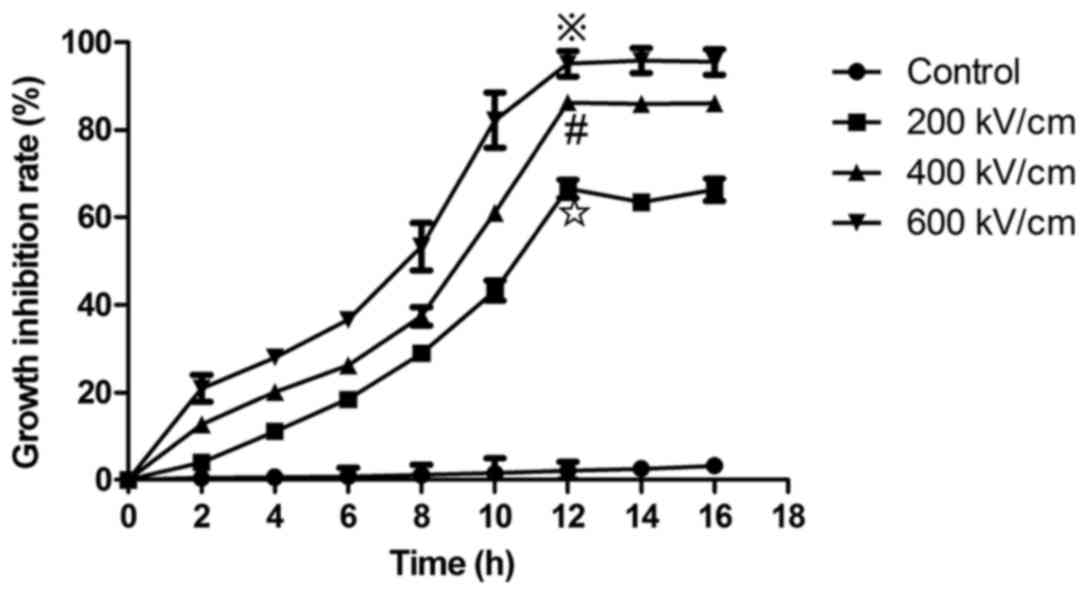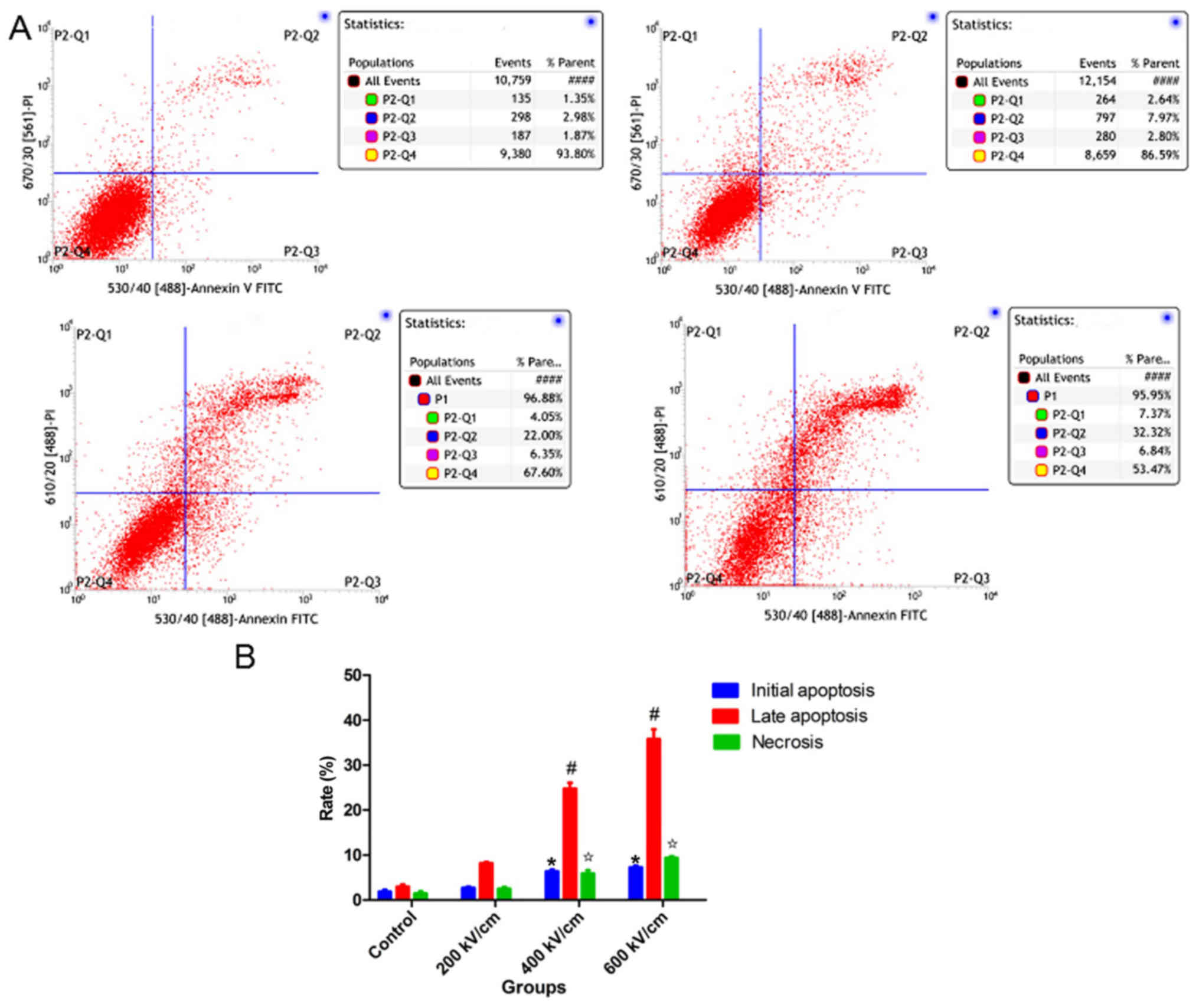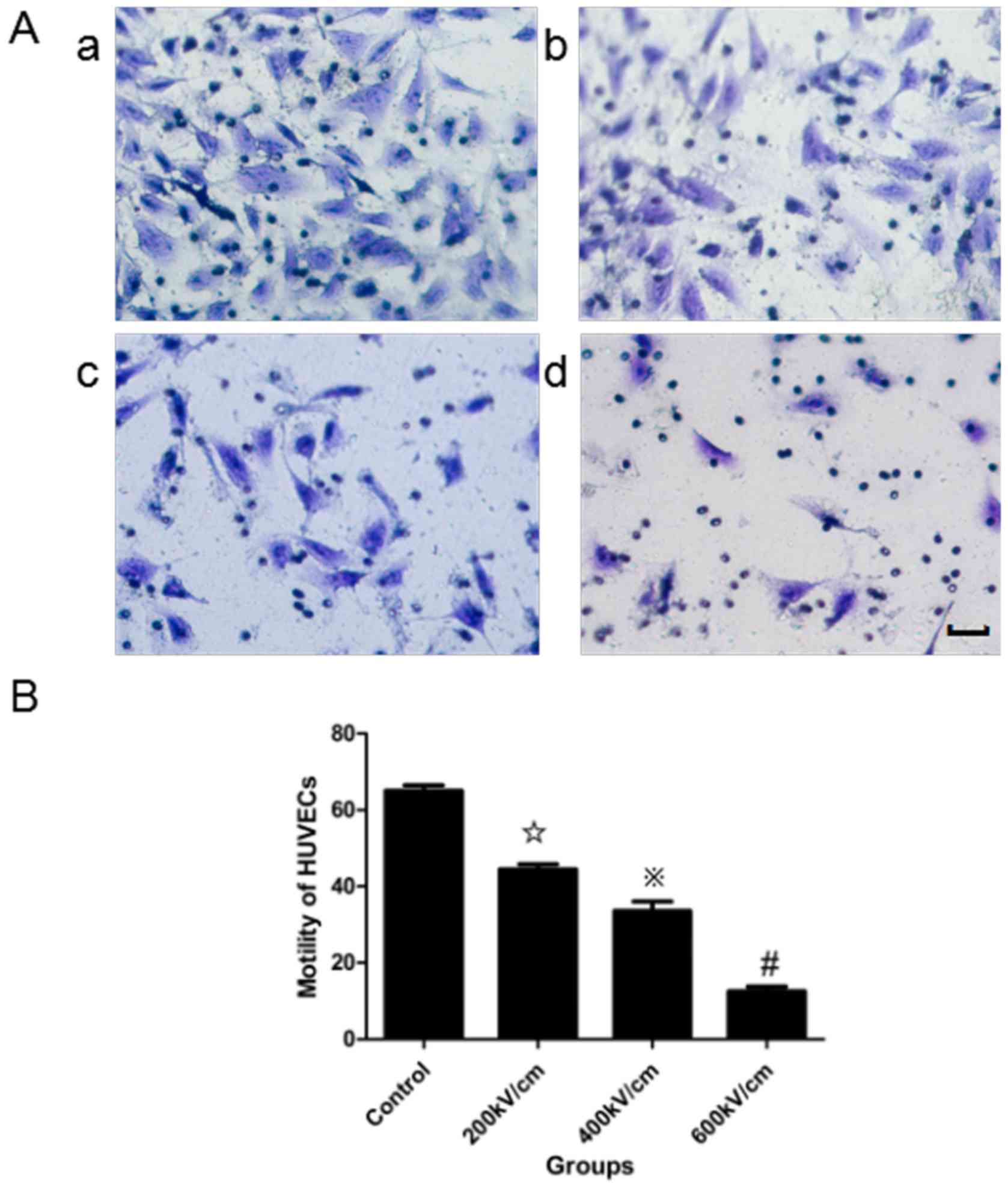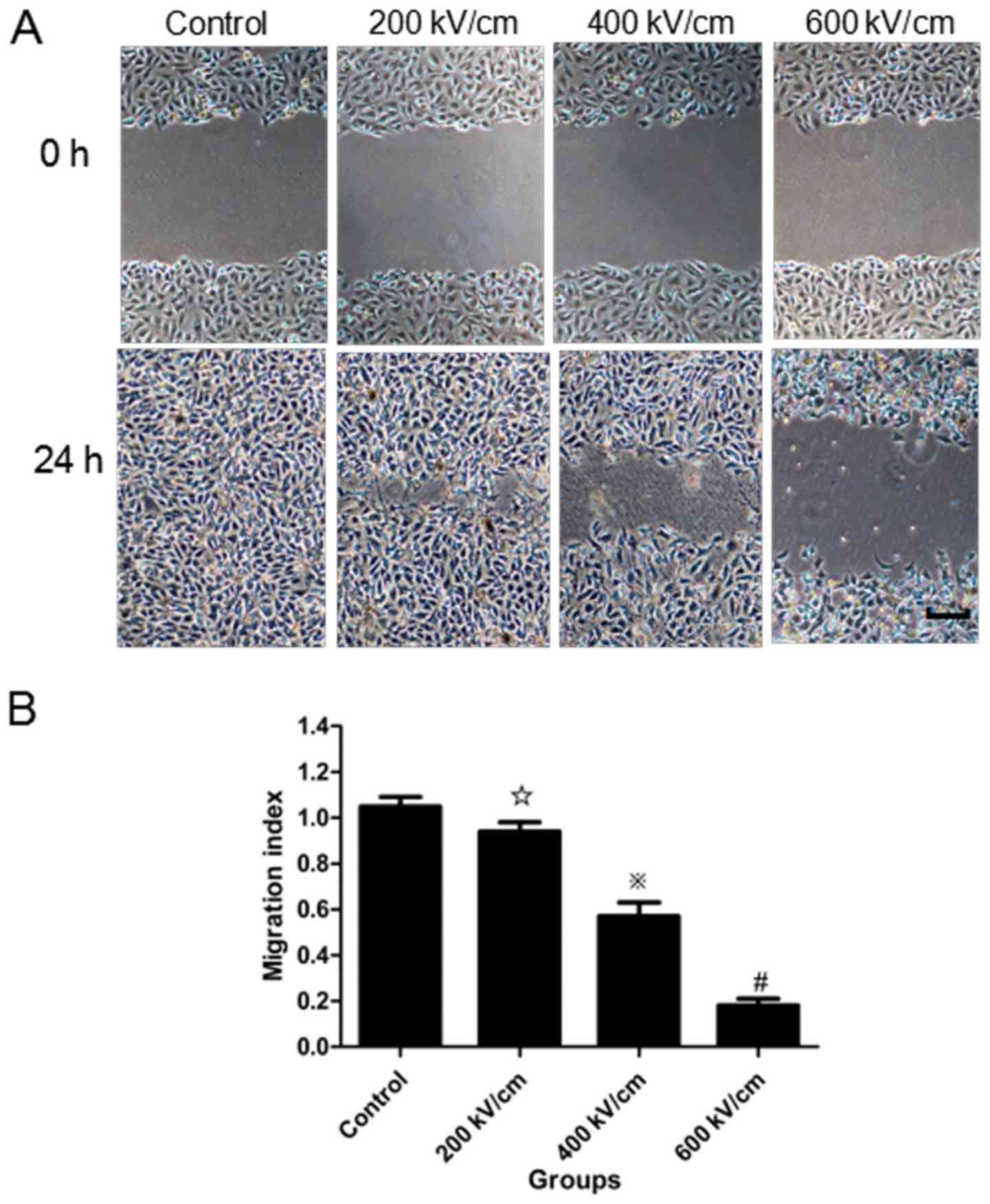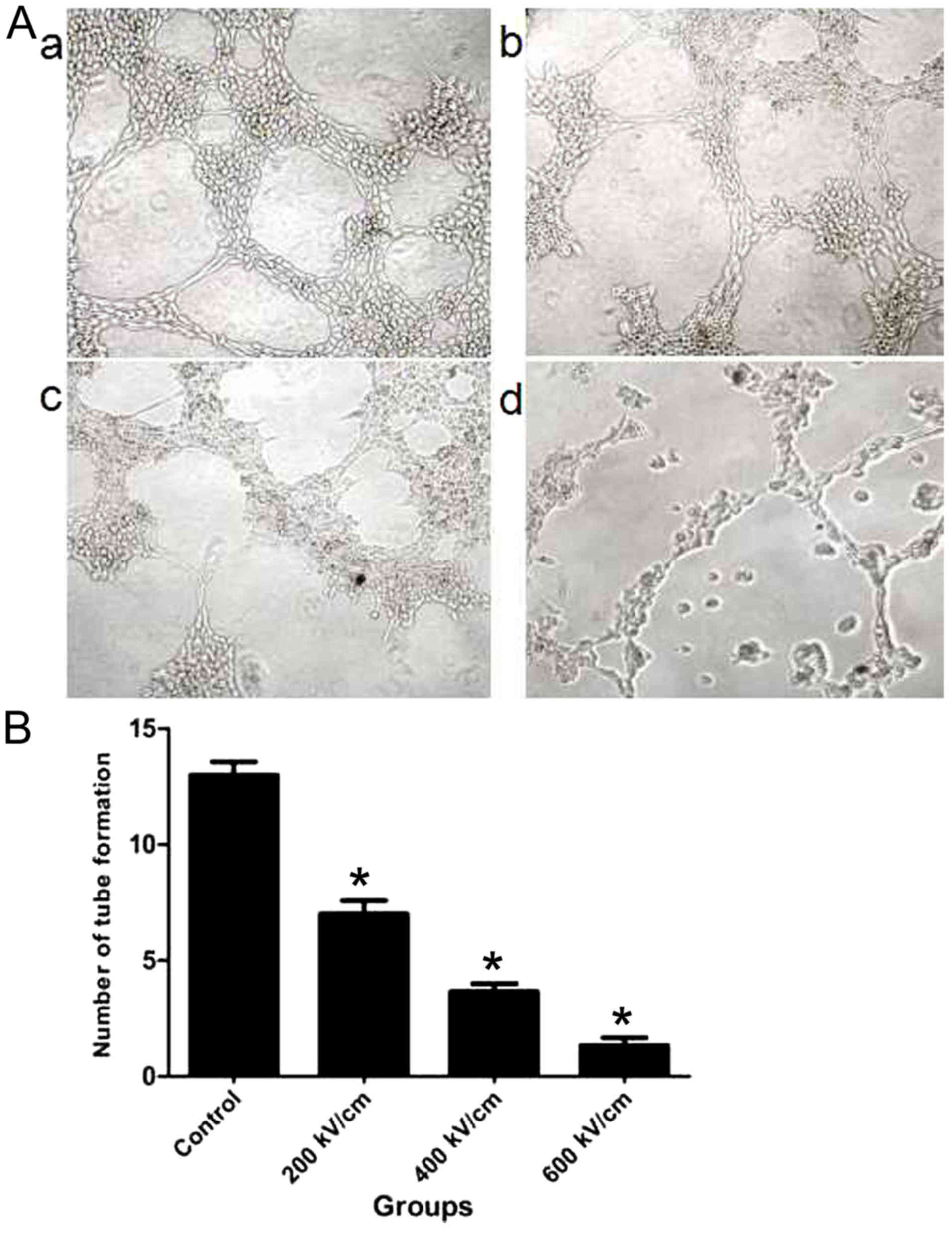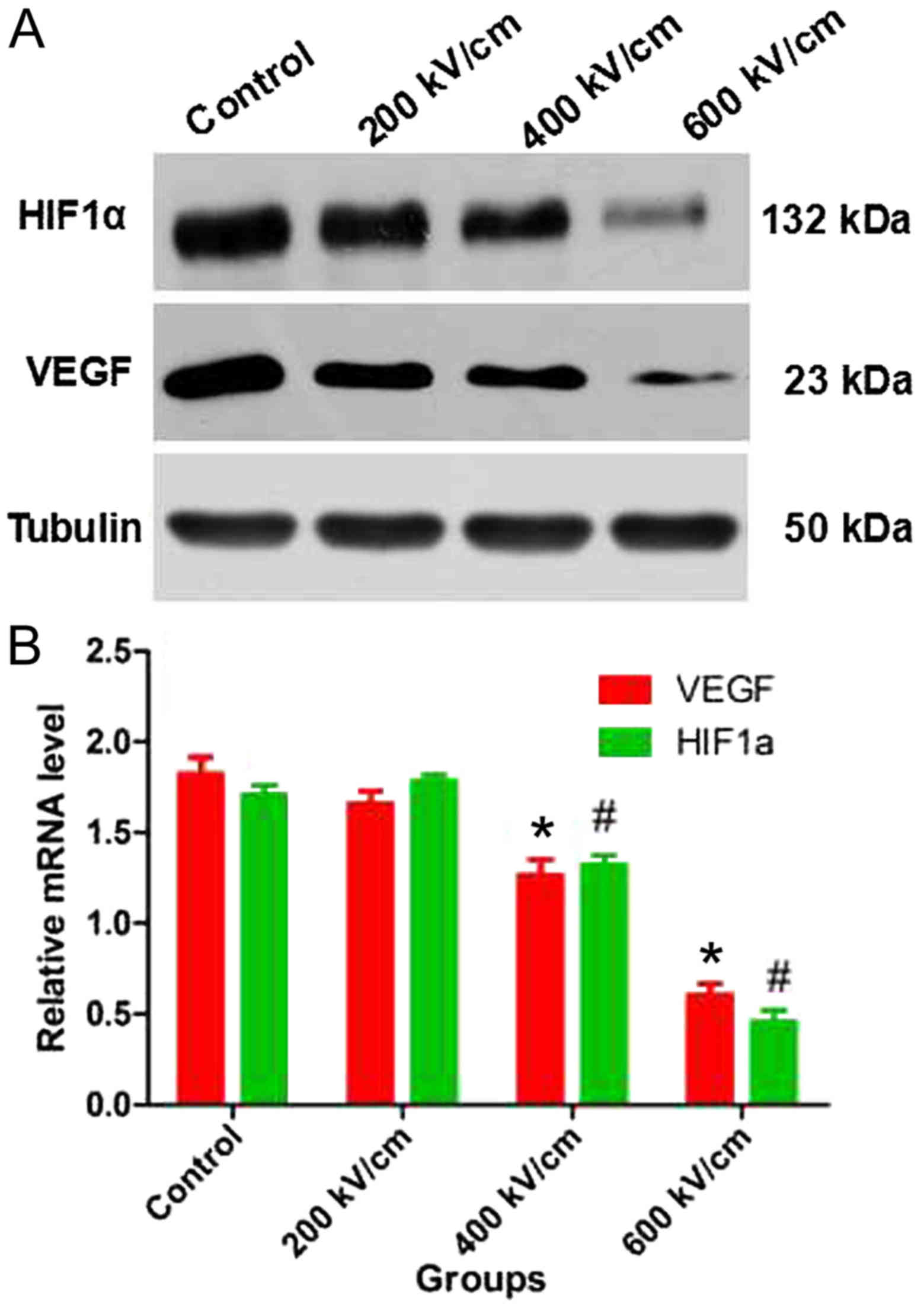Effects and possible mechanism of a picosecond pulsed electric field on angiogenesis in cervical cancer in vitro
- Authors:
- Published online on: November 30, 2018 https://doi.org/10.3892/ol.2018.9782
- Pages: 1517-1522
-
Copyright: © Wu et al. This is an open access article distributed under the terms of Creative Commons Attribution License.
Abstract
Introduction
Despite improvements due to an earlier diagnosis and improved treatment methods, cervical cancer remains a leading cause of cancer-associated mortality in women worldwide (1). Cervical cancer is preventable and often curable if it is detected early. However, a high proportion of patients exhibit a poor prognosis, as they are diagnosed with advanced stage, recurrent or persistent cervical cancer (2,3). Therefore, there is a requirement for the development of novel treatment strategies.
Neovascularization serves an important role in the tumor progression, invasion and metastasis of cervical cancer (2). Although specific inhibitors of angiogenesis have been clinically approved, toxicity and disruption of the normal vascular bed limit their application (4). Traditional surgery often causes serious harm to the reproductive organs and may affect sexual function and fertility (5–7). Therefore, it is important to effectively treat and reduce the side effects of traditional cervical cancer treatments.
Picosecond pulsed electric field (psPEF) technology involves use of an ultra-broadband spectrum with a high time and spatial resolution, and low signal distortion. psPEF may be used to non-invasively and precisely target deep tissue (8). To the best of our knowledge, the biological effects of psPEF are not fully understood. Our preliminary study demonstrated that psPEF exhibits necrotic and anti-angiogenic effects in cervical cancer xenograft models by exerting direct effects on cancer cells and vascular endothelial cells, and indirect effects on angiogenesis-associated factors (9). However, to the best of our knowledge, the effects of psPEF on cervical cancer angiogenesis in vitro remain unknown. To investigate the effects and possible mechanism of psPEF on angiogenesis in cervical cancer in vitro, human umbilical vein endothelial cells (HUVECs) and HeLa cells were exposed to psPEF. The proliferation, cell motility and tube formation capabilities of HUVECs were analyzed. In addition, the protein and mRNA expression levels of angiogenesis-associated factors, including vascular endothelial growth factor (VEGF) and hypoxia-inducible factor 1α (HIF-1α), were measured in HeLa cells following psPEF treatment. By studying the underlying mechanism, the antitumor effect of psPEF may be improved, which may enhance its clinical application.
Materials and methods
Cell culture and materials
HeLa cells and HUVECs were purchased from The Cell Bank of Type Culture Collection of Chinese Academy of Sciences (Shanghai, China) and cultured in high glucose Dulbecco's modified Eagle's medium (DMEM; Invitrogen; Thermo Fisher Scientific, Inc., Waltham, MA, USA) supplemented with 10% fetal bovine serum (GE Healthcare Life Sciences, Logan, UT, USA) and 1% penicillin-streptomycin at 37°C in a 5% CO2 incubator. Cell Counting kit-8 (CCK-8; Guangzhou Yiyuan Biological Technology Co., Ltd., Guangzhou, China), the Annexin V-fluorescein isothiocyanate (FITC) apoptosis detection kit (Nanjing KeyGen Biotech Co., Ltd., Nanjing, China), the anti-VEGF polyclonal antibody (no. bs-0279R; 1:200 dilution; Beijing Biosynthesis Biotechnology Co., Ltd., Beijing, China) and the anti-HIF-1α monoclonal antibody (cat. no. sc-13515; 1:500 dilution; Santa Cruz Biotechnology, Inc., Dallas, TX, USA) were used in the current study.
Field stimulation protocol
The following parameters were fixed: i) Frequency, 3 hertz; ii) duration, 800 picosec; and iii) pulse number, 2,000. Cells were randomly divided into four groups: The 200, 400 and 600 kV/cm psPEF treatment groups, and a control group that was administered no treatment. Following three washes with PBS, cells were combined with 0.125% trypsin-EDTA, and then centrifuged at 800 × g for 5 min at room temperature. Cells were then resuspended in fresh high glucose DMEM at a concentration of 1×106 cells/ml. Subsequently, the cell suspension (200 µl) was placed into a cuvette and power was supplied. The electric field amplitude and pulse width of psPEF was monitored throughout the experiment using a DP04054 oscilloscope (Tektronix, Inc., Beaverton, OR, USA). The control group was not connected to the power supply.
CCK-8 assay
Following psPEF treatment, the cell viability was investigated. HUVECs were transferred to 96-well plates containing 150 µl DMEM and 1×104 cells per well, and cultured for 2, 4, 6, 8, 10, 12, 14 or 16 h in a 5% CO2 humidified incubator at 37°C. Normal control (without psPEF treatment) and blank groups (without cells) were also included. Following incubation, 20 µl CCK-8 was added to each well and incubated for a further 2 h at 37°C. The optical density was measured at 470 nm using an ELx800 absorbance microplate reader (BioTek Instruments, Inc., Winooski, VT, USA).
Apoptosis analysis
HUVECs were grown in 25-cm2 culture flasks for 12 h after treatment in a 5% CO2 humidified incubator at 37°C. Cells were double-stained using an Annexin V-FITC apoptosis detection kit, according to the manufacturer's protocol. The cellular fluorescence was measured at an emission wavelength of 530 nm and an excitation wavelength of 488 nm using BD FACScan system (BD Biosciences, Franklin Lakes, NJ, USA) equipped with CellQuest Pro software version 5.1 (BD Biosciences, Franklin Lakes, NJ, USA).
In vitro migration assay
Transwell invasions assay were conducted in 24-well cell culture inserts The upper chamber with polycarbonate membrane (8 mm pore size) (Corning Incorporated, Corning, NY, USA) were covered with 40 µl Matrigel (1:4 dilution; BD Biosciences, Franklin Lakes, NJ, USA) and incubated for 24 h at 37°C. The lower chamber was filled with 750 µl DMEM with 10% FBS. Following psPEF treatment, the HUVECs cells were harvested and plated in complete medium on top of the culture insert at 5×104 cells per insert in 0.5 ml. The inserts were incubated at 37°C, 5% CO2 for 18 h. Non-invading cells were removed. Cells that had migrated through the pores were fixed with 4% paraformaldehyde for 30 min, stained in 0.5% crystal violet (Beyotime Institute of Biotechnology, Shanghai, China) for 10 min at room temperature and counted on a Leica CME microscope at total magnification, ×40. Three inserts were counted for each group and the experiment was repeated a minimum of three times.
In vitro wound-healing assay
Following psPEF treatment and incubation for 12 h in a 5% CO2 humidified incubator at 37°C, HUVECs were harvested, counted, plated at 4×105 cells/ml in 12-well dishes and incubated overnight at 37°C. Images were captured with a Leica CME microscope at ×20 total magnification immediately after wounds had been made with a pipette tip and following 24 h, and the distance migrated by the cells during this period was measured. The distance migrated by the psPEF treatment groups was calculated relative to the control group and expressed as the migration index. The experiment was repeated a minimum of three times.
Lumen formation test
The lumen formation assay was performed as described previously by Arnaoutova et al (10). Briefly, following psPEF treatment, HUVEC suspensions from the four treatment groups were added to the top of the gel at a density of 15,000 cells/well, incubated for 3 h in a 5% CO2 humidified incubator at 37°C and then imaged with a Leica CME microscope at total magnification, ×20.
Western blot analysis and reverse transcription-quantitative polymerase chain reaction (RT-qPCR)
HeLa cells from four groups (control, 200, 400 and 600 kV/cm psPEF tretment groups) were used. Western blot analysis and RT-qPCR were performed as described previously (11). The internal loading control was β-tubulin and bands were analyzed using Quantity One 4.6.2 software (Bio-Rad laboratories, Inc., Hercules, CA, USA). The primers used for RT-qPCR were as follows: VEGF forward, 5′-GTCCCAGGCTGCACCCATG-3′ and reverse, 5′-AGGAAGCTCATCTCTCCTA-3′; and HIF-1α forward, 5′-TCCATGTGACCATGAGGAAA-3′ and reverse, 5′-CCAAGCAGGTCATAGGTGGT-3′. β-tubulin forward, 5′-CCAAGGGTCACTACACG-3′ and reverse, 5′-GCAGTCGCAGTTTTCACACTC-3′; all data were normalized to the tubulin expression levels. Each experiment was performed in triplicate.
Statistical analysis
All data were analyzed using SPSS software (version 10.0; SPSS, Inc., Chicago, IL, USA) and expressed as the mean ± standard deviation of a minimum of three independent experiments. Statistical analysis was carried out by one-way analysis of variance (ANOVA), followed by Tukey's post-hoc test for multiple group comparisons, P<0.01 was considered to indicate a statistically significant difference.
Results
psPEF is associated with reduced cell survival
HUVECs were exposed to psPEF and cultured for 2, 4, 6, 8, 10, 12, 14 or 16 h. The CCK-8 assay was then used to analyze cell viability. The cell survival rate was taken as 100% for the control group. The cell growth inhibition rate was determined as: (The absorbance of normal control cells-the absorbance of psPEF treatment cells)/(the absorbance of normal control cells-the absorbance of the blank group) × 100. The results indicated that psPEF inhibited the growth of HUVECs in an electric field amplitude-dependent manner. An increased growth inhibition rate was associated with higher electric field amplitude and the maximum cell inhibition was observed at 12 h after psPEF treatment. The cells growth inhibition rate of the control, and the 200, 400 and 600 kV/cm psPEF treatment groups at 12 h following treatment with psPEF were 2.14±1.98, 66.53±0.2.12, 86.32±1.14 and 95.14±2.93%, respectively (※P<0.01, vs. the control, 200 and 400 kV/cm groups; #P<0.01, vs. the control and 200 kV/cm groups; ✩P<0.01, vs. the control group; Fig. 1).
psPEF induces apoptosis and necrosis of HUVECs
As demonstrated in Fig. 2, the apoptosis and necrosis rates of HUVECs following psPEF treatment were analyzed by flow cytometry. The mean initial apoptosis rates of the control, and the 200, 400 and 600 kV/cm psPEF treatment groups were 1.91±0.69, 2.74±0.42, 5.86±1.37 and 7.29±0.61%, respectively. The mean late apoptosis rates of the four groups were 3.00±0.81, 8.17±0.57, 24.71±2.39 and 35.83±3.65%, respectively. The mean necrosis rates of the four groups were 1.43±0.87, 2.49±0.80, 5.86±1.37 and 9.40±0.61%, respectively. The initial apoptosis, late apoptosis and necrosis rates were significantly increased in the 400 and 600 kV/cm treatment groups compared with the control group. In summary, the results indicated that psPEF could induce apoptosis and necrosis of HUVECs.
psPEF treatment impairs cell motility
A migration assay (Fig. 3) and in vitro wound-healing assay (Fig. 4) were used to assess the effects of psPEF on the motility of HUVECs. In the migration assay, the number of cells that moved across a microporous membrane following psPEF treatment was recorded. The data are expressed as motility indexes, which represent the number of cells that moved across the membranes relative to the control. The motility index of the control, and the 200, 400 and 600 kV/cm psPEF treatment groups was 65.11±2.43, 44.52±2.26, 33.63±4.17 and 12.52±2.13%, respectively. A statistically significant difference was identified in the motility index of the 400 and 600 kV/cm psPEF treatment groups compared with the control group (P<0.01). In the wound-healing assay, the distance moved by the wounded cells following treatment with different psPEF intensities was measured. The migration index for the control, and the 200, 400 and 600 kV/cm psPEF treatment groups was 1.05±0.04, 0.94±0.04, 0.57±0.06 and 0.18±0.03%, respectively. A statistically significant difference was identified in the 400 and 600 kV/cm psPEF treatment groups compared with the control group (P<0.01).
psPEF inhibits tube formation in HUVECs
Differences in tube formation were identified between the control and psPEF treatment groups (Fig. 5). HUVECs in the control group demonstrated adhesion and alignment (Fig. 5Aa). However, the psPEF-treated cells appeared less elongated and an inhibition of tube formation was identified (Fig. 5Ab-d). An increase in the psPF electric field intensity was associated with a decreased number of tubes. The mean number of tubes formed for the control, and the 200, 400 and 600 kV/cm psPEF treatment groups was 13.31±1.53, 7.23±0.58, 3.42±0.75 and 1.02±0.44, respectively (Fig. 5B). A statistically significant difference was identified between the control group and all psPEF treatment groups (P<0.01). These results indicated that psPEF inhibited tube formation in HUVECs.
psPEF reduces the protein and mRNA levels of VEGF and HIF-1α in HeLa cells
The protein and mRNA levels of VEGF and HIF-1α in HeLa cells were measured following psPEF treatment. Western blot analysis revealed that the protein levels of VEGF and HIF-1α were decreased in the 400 and 600 kV/cm groups compared with those in the control group (Fig. 6A). RT-qPCR identified that the mRNA levels of VEGF and HIF-1α were significantly decreased in the 400 and 600 kV/cm groups compared with those in the control group (P<0.01; Fig. 6B).
Discussion
Angiogenesis serves an important role in tumor invasion and metastasis, and is essential for tumor growth >1–2 mm3 (12,13). Folkman et al (12) reported that tumor growth requires tumor cell proliferation and angiogenesis. The basic requirement for angiogenesis is the proliferation and migration of vascular endothelial cells (14–17). Therefore, blocking these processes in vascular endothelial cells may inhibit tumor vascularization.
In the current study, psPEF inhibited the proliferation of HUVECs in a dose- and time-dependent manner. Furthermore, psPEF impaired the motility of HUVECs in a dose-dependent manner. Tumor blood vessels are predominantly composed of vascular endothelial cells; therefore, direct inhibition of tumor vascular endothelial cell growth is an important target to inhibit tumor growth, invasion and metastasis (13). The current study investigated whether psPEF may inhibit the angiogenesis of HUVECs using the lumen formation test. The results demonstrated that a decrease in the number of tubes was associated with an increase in the psPEF electric field intensity. Our previous study indicated that psPEF could induce apoptosis through a mitochondrial-mediated pathway in HeLa cells (11). In the current study, the apoptosis rate of HUVECs, particularly the late apoptosis rate, increased significantly compared with that of the control group. However, to the best of our knowledge, the underlying mechanism of this remains unknown.
Impairment of blood flow leads to tumor cell death due to a lack of nutrients and an accumulation of catabolite products (18,19). The inhibition of angiogenesis-associated factors inhibits blood flow, which leads to tumor growth inhibition (20). Hypoxia is considered to serve as a driving force for tumor angiogenesis (21). Tumor cells can adapt to hypoxia by altering the transcription of genes associated with angiogenesis, including VEGF and HIF-1α (22–25). In the current study, the protein and mRNA levels of VEGF and HIF-1α in HeLa cells were measured following treatment with psPEF. The results revealed that psPEF treatment is associated with decreased protein and mRNA levels of VEGF and HIF-1α. Therefore, we hypothesize that psPEF may indirectly decrease angiogenic activity in vitro by downregulating angiogenesis-associated factors in HeLa cells, which is consistent with our previous animal study (9).
In summary, the current study demonstrated that psPEF exhibited anti-angiogenesis effects in cervical cancer cells by two mechanisms. Firstly, psPEF exhibited a direct anti-angiogenic effect in vitro on HUVECs. Secondly, psPEF treatment was associated with a downregulation of angiogenesis-associated factors secreted by cancer cells, which suggests that psPEF could indirectly inhibit the formation of tumor vessels in vitro.
Acknowledgements
Not applicable.
Funding
The present study was supported by the National Natural Science Foundation of China (grant no. 81301928) and the Project Foundation of Chongqing Municipal Education Committee (grant no. KJ1500210).
Availability of data and materials
The datasets used and/or analyzed during the present study are available from the corresponding author on reasonable request.
Authors' contributions
ZX, CY and YH designed the experiments. LW, YW, MZ and RZ performed the experiments and collected data. CY, YH, LW, YW and RZ analyzed and interpreted the data. LW and YW drafted the manuscript. YH, ZX, LW and MZ revised the paper critically for important intellectual content. LW YW and YH agreed to be accountable for all aspects of the work in ensuring that questions related to the accuracy or integrity of any part of the study are appropriately investigated and resolved. All authors read and gave final approval of the version to be published.
Ethics approval and consent to participate
Not applicable.
Patient consent for publication
Not applicable.
Competing interests
The authors declare that they have no competing interests.
References
|
Landt S, Wehling M, Heidecke H, Jeschke S, Korlach S, Stöblen F, Schmid P, Blohmer JU, Lichtenegger W, Sehouli J and Kümmel S: Prognostic significance of angiogenic factors in uterine cervical cancer. Anticancer Res. 31:2589–2595. 2011.PubMed/NCBI | |
|
Monk BJ, Willmott LJ and Sumner DA: Anti-angiogenesis agents in metastatic or recurrent cervical cancer. Gynecol Oncol. 116:181–186. 2010. View Article : Google Scholar : PubMed/NCBI | |
|
Monk BJ and Herzog TJ: The evolution of cost-effective screening and prevention of cervical carcinoma: Implications of the 2006 consensus guidelines and human papillomavirus vaccination. Am J Obstet Gynecol. 197:337–339. 2007. View Article : Google Scholar : PubMed/NCBI | |
|
Ackermann M, Carvajal IM, Morse BA, Moreta M, O'Neil S, Kossodo S, Peterson JD, Delventhal V, Marsh HN, Furfine ES and Konerding MA: Adnectin CT-322 inhibits tumor growth and affects microvascular architecture and function in Colo205 tumor xenografts. Int J Oncol. 38:71–80. 2011.PubMed/NCBI | |
|
Verheul HM and Pinedo HM: Possible molecular mechanisms involved in the toxicity of angiogenesis inhibition. Nat Rev Cancer. 7:475–485. 2007. View Article : Google Scholar : PubMed/NCBI | |
|
Ma J and Waxman DJ: Combination of antiangiogenesis with chemotherapy for more effective cancer treatment. Mol Cancer Ther. 7:3670–3684. 2008. View Article : Google Scholar : PubMed/NCBI | |
|
Seol HJ, Ulak R, Ki KD and Lee JM: Cytotoxic and targeted systemic therapy in advanced and recurrent cervical cancer: Experience from clinical trials. Tohoku J Exp Med. 232:269–276. 2014. View Article : Google Scholar : PubMed/NCBI | |
|
Baum CE, Stone AP and Tyo JS: Ultra-wideband, short-pulse electromagnetics. 8th. New York: Springer; 2007, View Article : Google Scholar | |
|
Wu L, Yao C, Xiong Z, Zhang R, Wang Z, Wu Y, Qin Q and Hua Y: The effects of a picosecond pulsed electric field on angiogenesis in the cervical cancer xenograft models. Gynecol Oncol. 141:175–181. 2016. View Article : Google Scholar : PubMed/NCBI | |
|
Arnaoutova I, George J, Kleinman HK and Benton G: The endothelial cell tube formation assay on basement membrane turns 20: State of the science and the art. Angiogenesis. 12:267–274. 2009. View Article : Google Scholar : PubMed/NCBI | |
|
Hua YY, Wang XS, Zhang Y, Yao CG, Zhang XM and Xiong ZA: Intense picosecond pulsed electric fields induce apoptosis through a mitochondrial-mediated pathway in HeLa cells. Mol Med Rep. 5:981–987. 2012. View Article : Google Scholar : PubMed/NCBI | |
|
Folkman J: The role of angiogenesis in tumor growth. Semin Cancer Biol. 3:65–71. 1992.PubMed/NCBI | |
|
Eskander RN and Tewari KS: Targeting angiogenesis in advanced cervical cancer. Ther Adv Med Oncol. 6:280–292. 2014. View Article : Google Scholar : PubMed/NCBI | |
|
Kerbel RS: Tumor angiogenesis. N Engl J Med. 358:2039–2049. 2008. View Article : Google Scholar : PubMed/NCBI | |
|
Erös de Bethlenfalva-Hora C, Mertens JC, Piguet AC, Kettenbach J, Schmitt J, Terracciano L, Weimann R, Dufour JF and Geier A: Radiofrequency ablation suppresses distant tumour growth in a novel rat model of multifocal hepatocellular carcinoma. Clin Sci (Lond). 126:243–252. 2014. View Article : Google Scholar : PubMed/NCBI | |
|
Groblewska M, Siewko M, Mroczko B and Szmitkowski M: The role of matrix metalloproteinases (MMPs) and their inhibitors (TIMPs) in the development of esophageal cancer. Folia Histochem Cytobiol. 50:12–19. 2012. View Article : Google Scholar : PubMed/NCBI | |
|
Carmeliet P and Jain RK: Molecular mechanisms and clinical applications of angiogenesis. Nature. 473:298–307. 2011. View Article : Google Scholar : PubMed/NCBI | |
|
Ribatti D: Genetic and epigenetic mechanisms in the early development of the vascular system. J Anat. 208:139–152. 2006. View Article : Google Scholar : PubMed/NCBI | |
|
Denekamp J, Hill SA and Hobson B: Vascular occlusion and tumour cell death. Eur J Cancer Clin Oncol. 19:271–275. 1983. View Article : Google Scholar : PubMed/NCBI | |
|
Hajitou A, Grignet C, Devy L, Berndt S, Blacher S, Deroanne CF, Bajou K, Fong T, Chiang Y, Foidart JM and Noël A: The antitumoral effect of endostatin and angiostatin is associated with a down-regulation of vascular endothelial growth factor expression in tumor cells. FASEB J. 16:1802–1804. 2002. View Article : Google Scholar : PubMed/NCBI | |
|
Kaur B, Khwaja FW, Severson EA, Matheny SL, Brat DJ and Van Meir EG: Hypoxia and the hypoxia-inducible-factor pathway in glioma growth and angiogenesis. Neuro Oncol. 7:134–153. 2005. View Article : Google Scholar : PubMed/NCBI | |
|
Chaplin DJ and Horsman MR: The influence of tumour temperature on ischemia-induced cell death: Potential implications for the evaluation of vascular mediated therapies. Radiother Oncol. 30:59–65. 1994. View Article : Google Scholar : PubMed/NCBI | |
|
Noguera R, Fredlund E, Piqueras M, Pietras A, Beckman S, Navarro S and Påhlman S: HIF-1alpha and HIF-2alpha are differentially regulated in vivo in neuroblastoma: High HIF-1alpha correlates negatively to advanced clinical stage and tumor vascularization. Clin Cancer Res. 15:7130–7136. 2009. View Article : Google Scholar : PubMed/NCBI | |
|
Brown JM and Wilson WR: Exploiting tumour hypoxia in cancer treatment. Nat Rev Cancer. 4:437–447. 2004. View Article : Google Scholar : PubMed/NCBI | |
|
Vaupel P and Mayer A: Hypoxia in tumors: Pathogenesis-related classification, characterization of hypoxia subtypes, and associated biological and clinical implications. Adv Exp Med Biol. 812:19–24. 2014. View Article : Google Scholar : PubMed/NCBI |



